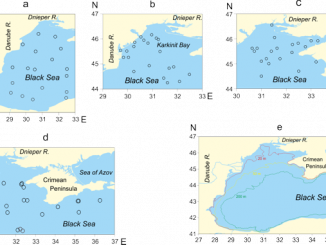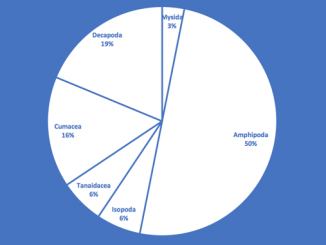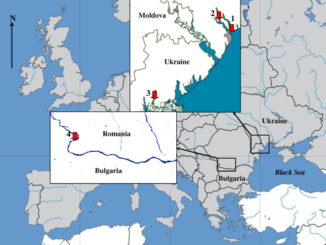
Paper category: Original research paper
Corresponding author: Ayşe Van (van_55.1986@hotmail.com)
DOI: 10.2478/oandhs-2021-0040
Received: 19/04/2021
Accepted: 01/07/2021
Full text: here
Citation (APA style): Van,A. & Gümüş,A.(2021).Determination of functional structure of soft-bottom marine macrobenthic communities of the Samsun Shelf Area using biological traits analysis. Oceanological and Hydrobiological Studies,50(4) 473-487. https://doi.org/10.2478/oandhs-2021-0040
Abstract
Biological Traits Analysis (BTA) was used to investigate the functional structure of marine macrobenthic communities along the Samsun Shelf Area (SSA). Benthic samples were collected seasonally from five different locations and at four different depths using a Van Veen grab sampler. Macrofaunal communities distributed in the SSA were assessed using 10 biological traits to identify characteristic traits for each depth and location. It was found that variability of benthic ecosystem functions in the SSA was driven by biological traits such as maximum size, living habit, sediment position, feeding mode and type of reproductive behavior. Bivalves, polychaetes and crustaceans of small to medium size, biodepositing, burying themselves in the sediment (burrowers) and feeding in suspension were relatively more abundant at depths of 0–60 m. However, the biomass of Amphiura, Abra, Papillicardium and some polychaetes characterized by medium to large sizes, diffusive mixing, free living and feeding on deposit and subsurface deposit showed higher values at depths below 60 m. In general, it is concluded that the functional structure of the benthic infauna in the SSA has adapted to physical disturbance, and communities distributed in this area consist mainly of taxa resistant to mechanical pressure.
Acknowledgements
We thank Dr. Serdar SÜER and Dr. Melih RÜZGAR for their contribution to the sampling process.
Funding
This study was funded by WP3 of the EU Project, FP7 BENTHIS (312088).
References
Aller, R. C. (1982). The effects of macrobenthos on chemical properties of marine sediment and overlying water. In Animal-sediment relations (pp. 53–102). Springer US.
Beauchard, O., Veríssimo, H., Queirós, A.M. & Herman, P.M.J. (2017). The use of multiple biological traits in marine community ecology and its potential in ecological indicator development. Ecological Indicators 76: 81–96.
Beaumont, N.J. & Tinch, R. (2003). Goods and services related to the marine benthic environment. Centre for Social and Economic Research on the Global Environment Working Paper, ECM 03-14. ISSN 0967-8875.
Bergmann, M.J.N. & Hup, M. (1992). Direct effects of beam trawling on macrofauna in a sandy sediment in the southern North Sea. ICES Journal of Marine Science 49(1): 5–11.
Bolam, S.G. (2012). Impacts of dredged material disposal on macrobenthic invertebrate communities: a comparison of structural and functional (secondary production) changes at disposal sites around England and Wales. Marine Pollution Bulletin 64(10): 2199–2210.
Bolam, S.G., Coggan, R.C., Eggleton, J.E., Diesing, M. & Stephens, D. (2013). Sensitivity of macrobenthic secondary production to trawling in the English sector of the Greater North Sea: a biological traits approach. Journal of Sea Research 85: 162–177.
Bolam, S.G. & Eggleton, J.D. (2014). Macrofaunal production and biological traits: Spatial relationships along the UK continental shelf. Journal of Sea Research 88: 47–58.
Bolam, S.G., Coggan, R.C., Eggleton, J.E., Diesing, M. & Stephens, D. (2014). Sensitivity of macrobenthic secondary production to trawling in the English sector of the Greater North Sea: a biological traits approach. Journal of Sea Research 85: 162–177.
Bremner, J., Frid, C.L.J. & Rogers, S.I. (2003). Assessing marine ecosystem health: the long-term effects of fishing on functional biodiversity in North Sea benthos. Aquatic Ecosystem Health & Management 6(2): 131–137.
Bremner, J., Frid, C.L.J. & Rogers, S.I. (2005). Biological traits of the North Sea benthos: does fishing affect benthic ecosystem function? In American Fisheries Society Symposium Vol. 41, p. 477, American Fisheries Society.
Bremner, J., Rogers, S. I. & Frid, C. L. J. (2006). Methods for describing ecological functioning of marine benthic assemblages using biological traits analysis (BTA). Ecological Indicators 6(3): 609–622.
Bremner, J. (2008). Species traits and ecological functioning in marine conservation and management. Journal of Experimental Marine Biology and Ecology 366(1): 37–47.
Cesar, C.P. & Frid, C.L.J. (2009). Effects of experimental small-scale cockle (Cerastoderma edule L.) fishing on ecosystem function. Marine Ecology 30(1): 123–137. ISSN 0173-9565.
Chevenet, F., Doledec, S. & Chessel, D. (1994). A fuzzy-coding approach for the analysis of long-term ecological data. Freshwater Biology 31(3): 295–309.
Clarke, K.R. & Warwick, R.M. (1994). An approach to statistical analysis and interpretation. Change in Marine Communities. Natural Environment Research Council, Plymouth, 2.
Daskalov, G.M. (2003). Long-term changes in fish abundance and environmental indices in the Black Sea. Marine Ecology Progress Series 255: 259–270.
Daskalov, G.M. (2008). Overfishing affects more than fish populations: trophic cascades and regime shifts in the Black Sea (pp. 418–433). Oxford, UK: Blackwell Publishing Ltd..
Darr, A., Gogina, M. & Zettler, M.L. (2014). Functional changes in benthic communities along a salinity gradient a western Baltic case study. Journal of Sea Research 85: 315–324.
Doledec, S. & Statzner, B. (1994). Theoretical habitat templets, species traits, and species richness: 548 plant and animal species in the Upper Rhone River and its floodplain. Freshwater Biology 31: 523–538.
Donadi, S., Eriksson, B.K., Lettmann, K.A., Hodapp, D., Wolff, J.O. & Hillebrand, H. (2015). The bodysize structure of macrobenthos changes predictably along gradients of hydrodynamic stress and organic enrichment. Marine Biology 162(3): 675–685. DOI: :10.1007/s00227-015-2614-z.
Dray, S., Choler, P., Doledec, S., Peres-Neto, P.R., Thuiller, W. et al. (2014). Combining the fourth‐corner and the RLQ methods for assessing trait responses to environmental variation. Ecology 95(1): 14–21.
Frid, C.L.J., Harwood, K.G., Hall, S.J. & Hall, J.A. (2000). Long-term changes in the benthic communities on North Sea fishing grounds. ICES Journal of Marine Science 57(5): 1303–1309.
Frid, C.L.J. (2011). Temporal variability in the benthos: does the sea floor function differently over time. Journal of Experimental Marine Biology and Ecology 400(1): 99–107.
Gilbert, F., Rivet, L. & Bertrand, J.C. (1994). The fate of petroleum hydrocarbons in marine sediments: influence of the burrowing polychaete Nereis diversicolor. Chemosphere 29: 1–12.
Gilbert, F., Hulth, S., Grossi, V., Poggiale, J.C., Desrosiers, G. et al. (2007). Sediment reworking by marine benthic species from the Gullmar Fjord (Western Sweden): importance of faunal biovolume. Journal of Experimental Marine Biology and Ecology 348(1): 133–144.
Gogina, M., Darr, A. & Zettler, M.L. (2014). Approach to assess consequences of hypoxia disturbance events for benthic ecosystem functioning. Journal of Marine Systems 129: 203–213.
Gomoiu, M.T. (1982). On the populations of Melinna palmata Grube at the romanian littoral of the Black Sea. Cercetări marine 15: 115–131.
Jennings, S. & Kaiser, M.J. (1998). The effects of fishing on marine ecosystems. Advances in Marine Biology 34: 201–352.
Kaiser, M.J. & Spencer, B.E. (1996). The effects of beam-trawl disturbance on infaunal communities in different habitats. Journal of Animal Ecology 65(3): 348–358.
KARTRIP (2020). Monitoring of Trawl Fisheries in The Black Sea, project number: TAGEM/ HAYSUD/2010/09/01/04. Fisheries Management (A09. P-01).
Kun, L., Heshan, L., Xuebao, H., Yaqinb, H., Zhong, L. et al. (2019). Functional trait com-position and diversity patterns of marine macrobenthos across the Arctic Bering Sea. Ecological Indicators. 102: 673–685. DOI: 10.1016/j.ecolind.2019.03.029.
Levinton J. (1995) Bioturbators as ecosystem engineers: control of the sediment fabric, inter-individual interactions, and material fluxes. In C.G. Jones & J.H. Lawton (Eds.), Linking Species & Ecosystems (pp. 29–36). Boston, MA: Springer
Loo, L.O. & Rosenberg, R.(1989). Bivalve suspension-feeding dynamics and benthic-pelagic coupling in an eutrophicated marine bay. Journal of Experimental Marine Biology and Ecology 130(3): 253–276.
McHugh, D. & Fong, P.P. (2002). Do life history traits account for diversity of polichaete anellids? Invertebrate Biology 121(4): 325–338.
Mermillod-Blondin, F., Nogaro, G., Vallier, F. & Gibert, J. (2008). Laboratory study highlights the key influences of stormwater sediment thickness and bioturbation by tubificid worms on dynamics of nutrients and pollutants in stormwater retention systems. Chemosphere 72(2): 213–223.
Mermillod-Blondin, F. (2011). The functional significance of bioturbation and biodeposition on biogeochemical processes at the water−sediment interface in freshwater and marine ecosystems. Journal of the North American Benthological Society 30(3): 770−778.
Munari, C. (2013). Benthic community and biological trait composition in respect to artificial coastal defence structures: a study case in the northern Adriatic Sea. Marine environmental research 90: 47−54.
Muntadas, A., de Juan, S. & Demestre, M. (2015). Integrating the provision of ecosystem services and trawl fisheries for the management of the marine environment. Science of The Total Environment 506: 594−603.
Nasi, F., Nordström, M.C., Bonsdorff, E., Auriemma, R., Cibic, T. et al. (2018). Functional biodiversity of marine soft-sediment polychaetes from two Mediterranean coastal areas in relation to environmental stress. Marine environmental research 137: 121−132.
Newell, R.I.E. (2004). Ecosystem influences of natural and cultivated populations of suspension-feeding bivalve molluscs: a review. Journal of Shellfish Research 23(1): 51−62.
Ockelmann, K.W. & Muus, K. (1978). The biology, ecology and behaviour of the bivalve Mysella bidentata (Montagu). Ophelia 17(1): 1–93.
Oguz, T., Akoglu, E. & Salihoglu, B. (2012). Current state of overfishing and its regional differences in the Black Sea. Ocean & coastal management 58: 47–56.
Oug, E., Fleddum, A., Rygg, B. & Olsgard, F. (2012). Biological traits analyses in the study of pollution gradients and ecological functioning of marine soft bottom species assemblages in a fjord ecosystem. Experimental Marine Biology and Ecology 432: 94–105.
Paganelli, D., Marchini, A. & Occhipinti-Ambrogi, A. (2012). Functional structure of marine benthic assemblages using Biological Traits Analysis (BTA): a study along the Emilia–Romagna coastline (Italy, North-West Adriatic Sea). Estuarine, Coastal and Shelf Science 96: 245–256.
Prantoni, A.L., Da Cunha Lan, P., Sandrini-Neto, L., Filho, O.A.N. & De Oliveira, V.M. (2013). An experimental evaluation of the short-term effects of trawling on infaunal assemblages of the coast off southern Brazil. Journal of the Marine Biological Association of the UK. 93(02): 495–502.
Quintana, C.O., Tang, M. & Kristensen, E. (2007). Simultaneous study of particle reworking, irrigation transport and reaction rates in sediment bioturbated by the polychaetes Heteromastus and Marenzelleria. Journal of Experimental Marine Biology and Ecology. 352(2): 392−406.
Reizopoulou, S. & Nicolaidou, A. (2007). Index of size distribution (ISD): a method of quality assessment for coastal lagoons. In Lagoons and Coastal Wetlands in the Global Change Context: Impacts and Management Issues (pp. 141−149). Springer Netherlands.
Rhoads, D.C. & Boyer, L.F. (1982). The effects of marine benthos on physical properties of sediments. In Animal-sediment relations (pp. 3–52). Springer US.
Sahin, G.K. & Cinar, M.E. (2012). A check-list of polychaete species (Annelida: Polychaeta) from the Black Sea. Journal of Black Sea/Mediterranean Environment 18(1): 10–48.
Sciberras, M., Hinz, H., Bennell, J.D., Jenkins, S.R., Hawkins, S.J. et al. (2013). Benthic community response to a scallop dredging closure within a dynamic seabed habitat. Marine Ecology Progress Series 480: 83 – 98.
Surugiu, V. (2000). Des modifications survenues dans la structure des populations des Annélides Polychètes d’Agigea dans les 30 dernières années. Analete Stiintifice ale Universitatii" Al. I. Cusa" Iasi, s. Biologie animala 46: 73–81.
Surugiu, V. (2005). The use of polychaetes as indicators of eutrophication and organic enrichment of coastal waters: A study case – Romanian Black Sea coast. Analete Stiintifice ale Universitatii "Al. I. Cusa" Iasi, s. Biologie animala. 51: 55–62.
Surugiu, V. & Feunteun, M. (2008). The structure and distribution of polychaete populations influenced by sewage from the Romanian Black Sea coast. Analete Stiintifice ale Universitatii "Al. I. Cusa" Iasi, s. Biologie animala. 54: 177–184.
Surugiu, V. (2009). The influence of sewage pollution on polychaetes associated to mussel beds of Romanian Black Sea coast. Geo-Eco-Marina 15: 77–87.
Surugiu, V. (2011). Polychaete research in the Black Sea. Romanian Journal of Aquatic Ecology 1(1): 101–122.
Solan, M., Batty, P., Bulling, M.T. & Godbold, J.A. (2008). How biodiversity affects ecosystem process: implications for ecological revolutions and benthic ecosystem function. Aquatic Biology 2: 289–301.
Thrush, S.F., Hewitt, J.E., Gibbs, M., Lundquist, C. & Norkko, A. (2006). Functional role of large organisms in intertidal communities: community effects and ecosystem function. Ecosystems 9(6): 1029–1040.
Tillin, H.M., Hiddink, J.G., Jennings, S. & Kaiser, M.J. (2006). Chronic bottom trawling alters the functional composition of benthic invertebrate communities on a sea-basin scale. Marine Ecology Progress Series 318: 31–45.
Usseglio-Polatera, P., Bournaud, M., Richoux, P. & Tachet, H. (2000). Biomonitoring through biological traits of benthic macroinvertebrates: how to use species trait databases? In Assessing the Ecological Integrity of Running Waters. Springer Netherlands 153–162.
van Denderen, P.D., van Kooten, T. & Rijnsdorp, A.D. (2013). When does fishing lead to more fish? Community consequences of bottom trawl fisheries in demersal food webs. Proceedings of the Royal Society of London B: Biological Sciences. 280(1769): 20131883.
van der Linden, P., Patrício, J., Marchini, A., Cidc, N., Netoa, J.M. et al. (2012). A biological trait approach to assess the functional composition of subtidal benthic communities in an estuarine ecosystem. Ecological Indicators 20: 121–133.
van Son, T.C., Oug, E., Halvorsen, R. & Melsom, F. (2013). Gradients in traits composition and their relation to environmental complex-gradients and structuring processes: a study of marine sediment species communities. The Open Marine Biology Journal 7: 14–27.
Villnäs, A., Norkko, J., Lukkari, K., Hewitt, J. & Norkko, A. (2012). Consequences of increasing hypoxic disturbance on benthic communities and ecosystem functioning. PLoS One 7(10): e44920. DOI: 10.1371/journal.pone.0044920.
Wan Hussin, W.M.R., Cooper, K.M., Frojan, C.R.S.B., Defew, E.C. et al. (2012). Impacts of physical disturbance on the recovery of a macrofaunal community: a comparative analysis using traditional and novel approaches. Ecological Indicators 12(1): 37–45.
Wilson, W.H. (1991). Competition and predation in marine soft-sediment communities. Annual Review of Ecology and Systematics 21: 221–241.



